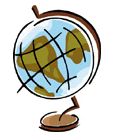Learn about the expansion of Canada and what it is like today.
 Objectives:
Objectives:
- Students will be able to describe the expansion of Canada.
- Students will be able to identify the Canadian Pacific Railway as an important factor in the expansion of Canada.
- Students will be able to identify the various immigrant groups who have settled in Canada and the circumstances under which each group arrived.
- Students will be able to identify French and English as the two official languages of Canada.
Suggested Grades:
4th Grade – 5th Grade – 6th Grade
Procedure:
- Read lesson or have students read it silently.
- Have students answer the questions on the worksheet.
- Discuss answers to questions.
Lesson Excerpt:
When Canada became a country in 1867, most Canadians lived in the southeastern part of the country. While a few people lived on the plains and along the west coast, they were separated from the rest of the population by the Canadian Shield and the steep mountains of the Canadian Rockies. The Prime Minister, John McDonald, wanted Canada to be a country that spanned from the Atlantic to the Pacific. He decided that the best way to unite the distant territories with the rest of the nation was to build a railroad, and that’s what he promised to do.
The promise of a railroad encouraged more provinces to become part of the country. In 1870, the plains province of Manitoba joined the nation, and in 1871, the west coast province of British Columbia was added. But it was not until 1881 that the construction of the Canadian Pacific Railway finally began. Under the direction of the American engineer William Van Horne, the railway was completed in 1885. Later, in 1905, two more plains provinces – Alberta and Saskatchewan – became part of Canada. The country now stretched from sea to sea.
 Objectives:
Objectives: